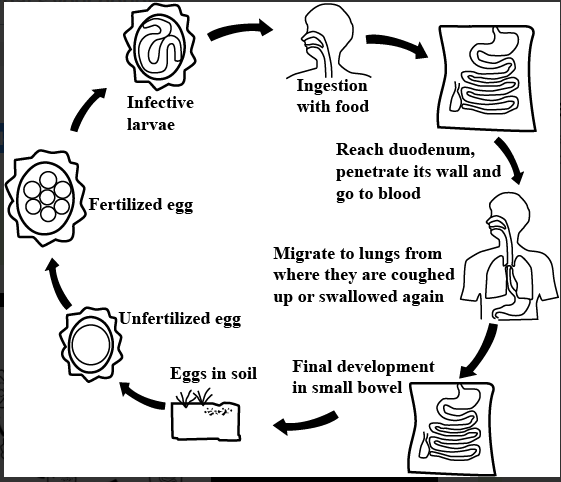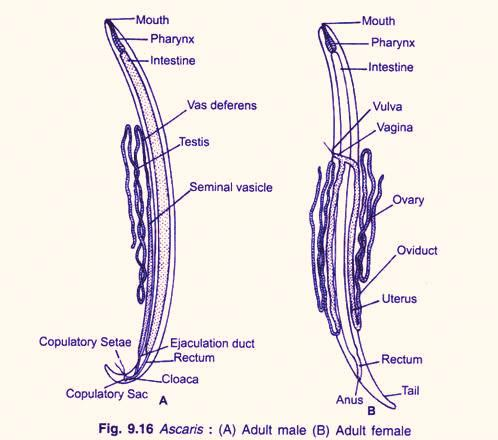Step-by-Step Guide: How Ascaris Infects Humans and Spreads
Ascaris lumbricoides is a nematode (roundworm) commonly found in the human small intestine, causing an infection known as Ascariasis. These worms can grow up to 40 cm and have a cylindrical body protected by a thick cuticle. They are capable of producing thousands of eggs daily, which can spread through contaminated water or food. Children with heavy infections may face digestive problems, malnutrition, and stunted growth. Understanding the structure and life cycle of these roundworms is vital for learning how to prevent and control infections.
Structure of Ascaris lumbricoides

Basic Body Form
Ascaris lumbricoides is cylindrical with a pseudocoelom (a fluid-filled cavity).
It has bilateral symmetry, meaning the body can be divided into two similar halves.
Body Covering
The outer layer is a tough, non-cellular cuticle.
Beneath the cuticle lies the epidermis, which helps maintain body shape and protection.
Digestive System
The worm has a complete alimentary canal with a mouth, pharynx, intestine, and anus.
The mouth is surrounded by three lips, enabling it to ingest food from the host’s intestine.
Sexual Dimorphism
Males are smaller (up to 30 cm) with a curved tail end.
Females are longer (up to 40 cm) with a straight tail end and can lay thousands of eggs daily.
Excretory and Nervous System
Wastes are expelled through an excretory pore.
A simple nervous system coordinates basic movements.
Life Cycle of Ascaris lumbricoides

Egg Stage
Adult female worms in the small intestine release fertilised eggs into the intestines.
These eggs exit the body in faeces and become infective in soil within a few weeks under warm, moist conditions.
Larva Stage
When infective eggs are accidentally swallowed (via contaminated food or water), they hatch in the host’s intestine.
The larvae then move through the intestinal wall and travel via the bloodstream to the lungs.
After maturing in the lungs briefly, they ascend the respiratory tract to the throat and are swallowed again, returning to the intestine.
Adult Stage
Larvae develop into adult worms in the small intestine, feeding on the host’s intestinal contents.
Adult worms can survive for 1–2 years, with females laying thousands of eggs each day, continuing the infection cycle.
Quick Quiz (With Answers)
Which body part do Ascaris eggs primarily exit from in humans?
A. Mouth
B. Nose
C. Intestine
D. Skin
Answer: C (They are passed out in faeces through the intestine.)
Where do Ascaris larvae usually mature before returning to the intestine?
A. Stomach
B. Lungs
C. Pancreas
D. Gallbladder
Answer: B (They typically migrate to the lungs first.)
What is the lifespan of an adult Ascaris worm?
A. 1–2 years
B. 2–3 weeks
C. 5–6 months
D. 3–4 years
Answer: A (An adult worm can live for 1–2 years.)


FAQs on Ascaris Life Cycle: Key Stages, Hosts & Prevention
1. What are the key stages in the life cycle of Ascaris lumbricoides?
The life cycle of Ascaris lumbricoides is completed in a single host (human) and consists of three main stages:
- Egg Stage: Fertilised eggs are passed from an infected person's body through faeces. They become infective after maturing in warm, moist soil for several weeks.
- Larva Stage: When infective eggs are ingested, they hatch in the intestine. The larvae penetrate the intestinal wall, travel to the lungs via the bloodstream, mature further, and are then swallowed again.
- Adult Stage: After being swallowed, the larvae develop into adult worms in the small intestine, where they live, reproduce, and lay eggs, continuing the cycle.
2. How can you distinguish between a male and a female Ascaris worm?
Male and female Ascaris lumbricoides show clear sexual dimorphism. The female worm is typically longer and thicker, reaching up to 40 cm, with a straight posterior end. The male worm is smaller, usually up to 30 cm long, and is easily identified by its curved or hooked posterior tail.
3. What is the primary route of transmission for Ascariasis in humans?
The primary route of transmission is the fecal-oral route. Infection occurs when a person accidentally ingests mature, infective Ascaris eggs. This commonly happens by consuming contaminated food or water, or through hands contaminated with soil where these eggs are present.
4. What are the main symptoms of a severe Ascaris infection?
While mild infections may have no symptoms, a heavy infestation of Ascaris worms can cause serious health issues. The main symptoms include abdominal pain, nausea, nutritional deficiencies, and stunted growth in children. In severe cases, a large mass of worms can cause a dangerous intestinal blockage.
5. Why do Ascaris larvae need to migrate to the lungs if they ultimately mature in the intestine?
The migration to the lungs is a mandatory and crucial developmental step for the larvae. The oxygen-rich environment of the lungs is required for the larvae to moult and mature to a stage that can survive and develop into an adult worm back in the small intestine. Without this journey, the life cycle cannot be completed.
6. How does the body structure of Ascaris help it survive as an internal parasite?
The structure of Ascaris is well-adapted for survival inside the human intestine. Its most important feature is a thick, tough outer layer called the cuticle, which protects it from being digested by the host's powerful digestive enzymes and acidic environment. It also has a simple muscular and nervous system for movement against intestinal peristalsis.
7. Why is ascariasis more prevalent in regions with poor sanitation?
Ascariasis is closely linked to sanitation because the parasite's life cycle depends on the contamination of soil with human faeces. In areas with poor sanitation, a lack of proper toilets leads to soil contamination with infective eggs. These eggs can then easily spread to food, water, and hands, leading to a higher rate of infection within the community.
8. What does it mean for Ascaris to be a monogenetic parasite?
A monogenetic parasite is an organism that completes its entire life cycle within a single host. Ascaris lumbricoides is a classic example because it does not require an intermediate host; it completes all stages of its development, from egg to reproducing adult, solely within the human body.










